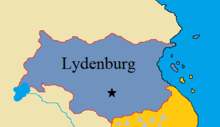Lydenburg
The Trekboer Republic of Lydenburg
Die Trekboere Republiek van Lydenburg |
||||||
|---|---|---|---|---|---|---|
|
||||||
| Motto: Soli Deo Gloria (Glory to God alone) |
||||||
| Anthem: Die Boerenkrijgslied (Dutch) | ||||||
| Capital and largest city | Lydenburg | |||||
| Official languages | Afrikaans | |||||
| Ethnic groups | Mainly Afrosians (blacks); the rest white, Coloureds; Asiatics | |||||
| Demonym | Lydenburger | |||||
| Government | Republic | |||||
| - | Prime Minister | Hendrik Strydom | ||||
| - | Staatspresident | Gerrit Scheepers | ||||
| Legislature | Volksraad | |||||
| Sovereignty | ||||||
| - | Asserted | 26 May 1542 | ||||
| - | Declared | 17 December 1856 | ||||
| Area | ||||||
| - | Total | 746,253 km2 288,130 sq mi |
||||
| - | Water (%) | 0.14 | ||||
| Population | ||||||
| - | June 2012 estimate | 7,600,000 | ||||
| - | 2010 census | 7,415,595 | ||||
| - | Density | 18/km2 46.6/sq mi |
||||
| GDP (PPP) | 2013 estimate | |||||
| - | Total | $53 billion | ||||
| - | Per capita | $1,352 | ||||
| Gini (2010) | very high |
|||||
| HDI (2011) | low |
|||||
| Currency | Burgerpond (VBP) |
|||||
| Time zone | CAT (UTC+2) | |||||
| - | Summer (DST) | not observed (UTC+2) | ||||
| Drives on the | left | |||||
| Calling code | +013 local | |||||
| Internet TLD | .lyd | |||||
Lydenburg forms a vast, wedge-shaped, block of predominantly barren territory which has cultivated a harsh and unforgiving climate. It lies astride the western rim of the subcontinental Traaksvaai Basin, to which it rises in a sharp coastal escarpment and from which it then slopes gradually to the east and north. Except in the southern provinces, most of the country receives under four hundred millimetres of raindfall per year, with an average hovering close to two hundred and seventy millimetres. Rainfall generally increases from the coast inland, creating agricultural zones which correspond roughly to these patterns: minor plantations and subsistence farming in the far north, small animal stock such as merino sheep in the south, and large animal stock (including cattle) in the central to northern regions.
Despite the fact that over half the nation is dry and unfertile, it remains rich in mineral deposits, including diamonds and uranium. Most Lydenburgers dwell live in the forested northern provinces and in the high, arid, plateau between the Traaksvai and Henestadt deserts. One of the largest ethnic groups is the BaPedi, which lives in the south and comprises a significant percentage of the country's population. Over half the citizens speak Pedi, Lbomba, or Macatese. English and Afrikaans are the most widely used languages in schools, government, and businesses, but native peoples continue to maintain the African tongues of their homelands. None of the indigenous dialects are afforded official recognition; over fifteen are spoken in the territory.
Lydenburg's people are predominantly black sub-saharan Africans, but the country is ruled by a government dominated entirely by local white settlers. The former account for over seventy per cent of the total population. White people of Dutch, German, and Flemish ancestry represent roughly twenty per cent. Many hold administrative jobs in urban areas. Living standards do vary, but most black Lydenburgers must struggle to make a living. Whites have higher incomes and better medical and educational facilities than do blacks.
The institutionalised racialism in practise today can be traced back to the beginning of early colonial penetration, when European farmers and merchants arrived to plunder the territory's riches. Indigenous tribes were gradually pushed off their land, and the African status eroded to the point that most were simply driven into overcrowded reserves to be used as units of labour for white-owned enterprises. The natives did not accept these land divisions submissively, and resistance against Lydenburg's minority regime has ranged from passive demonstrations to guerilla war. The white authorities follow an overt baaskap policy, and have imposed measures barring blacks from public facilities and accomodations. Total segregation has also been practised in eating places, parks, sports facilities, theatres, and toilets. The result has been a society marked by white supremacy and black subordination. Membership within a particular racial category regulates access to jobs in government and private industry, as well as the quality of education, modern housing, and social welfare.
Presently, an increasing number of educated Lydenburgers envision - though the law does not allow them to express it - a future nonracial society where everybody willing to contribute to a united, peaceful, Lydenburg will be accepted - a society that seems increasingly remote as the racial lines continue to be entrenched.
All in all, the nation's population is so compounded racially as to form a highly explosive mixture. In their attempts to preserve the existing socioeconomic order, the tyrannies of the current regime are now combining to heat this mixture to a point where the world waits apprehensively for the explosion.



